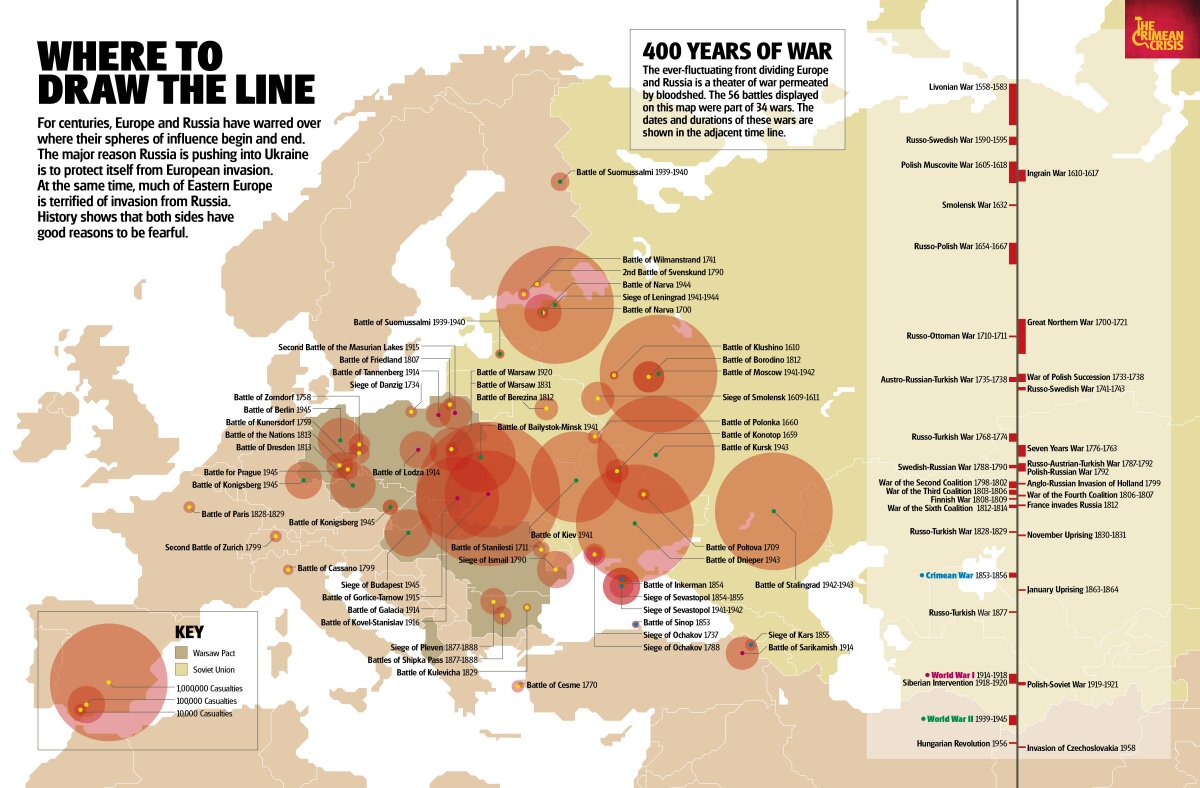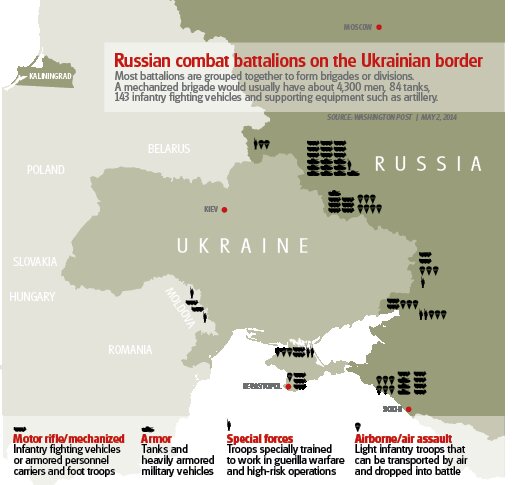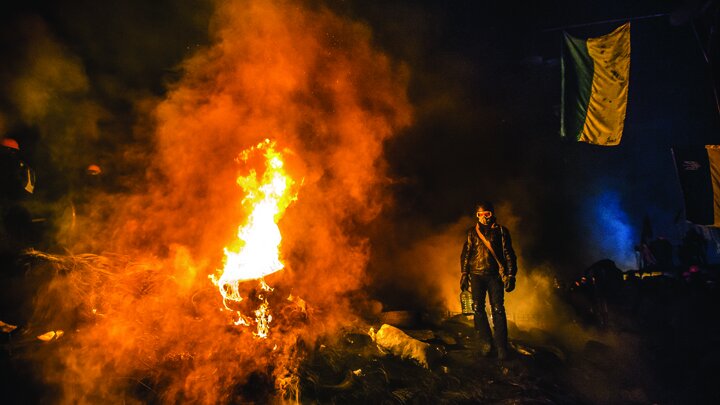Why Russia Is Marching—and Eastern Europe Is Afraid
Few people in the world are more familiar with brutality than Eastern Europeans. Caught between the major powers of the West and the might of Russia, they have witnessed the worst of the worst conflicts in history. More men have died by the hand of their fellow man in this region than anywhere else in the world.
The World War ii battles that the Western world is most familiar with, including D-Day and the Battle of the Bulge, took place on the Western front—where fewer than 4 million soldiers died. That hardly compares to the bloodshed on the Eastern front, where battles claimed roughly 17 million soldiers’ lives. And that doesn’t include the huge number of civilians who lost their lives in the Battle of Stalingrad, the Siege of Leningrad and other horrific clashes. In fact, Western front losses don’t even match those on the Eastern front in the First World War: An estimated 5 million soldiers became corpses there.
This history is critical to understand the crisis in Ukraine. That nation and several others in Eastern Europe are becoming a battleground in a turf war between Europe and Russia.
From the West’s perspective, Russia’s fear of European expansion into Ukraine seems like bizarre paranoia. But given Russia’s history—and how, time and again, Russians have suffered terribly under European aggressors—it is reasonable caution.
At the same time, Eastern Europeans have suffered terribly under the Russians, and not just during the Cold War. Given that history, their fear that Russia will strike beyond Crimea is also well justified.
Why Eastern Europe Is Shaken
The freedom Eastern Europe currently enjoys is actually a historical anomaly. For most of the 20th century, the whole region was ruled by Russia. Estonia, Latvia, Lithuania and Poland spent only 30 of those 100 years self-governing and free.
Central and Eastern European nations can exist independently only when the surrounding powers are weak. The last time this was the case for an extended period was more than 500 years ago. In the 13th century, the Mongols conquered Russia from the east, keeping the country in their thrall for over 200 years. Meanwhile, Germany had not yet united and become mainland Europe’s major power.
This vacuum allowed the Polish-Lithuanian Commonwealth to thrive, officially forming in 1569. Sweden was also a major power in the area, while German knights ruled the region that is now Estonia and Latvia. With no threat coming from the East, Poland was able to hold its own.
In the south, the Ottoman Empire filled the vacuum. The Ottomans conquered Bulgaria at the end of the 14th century, then Moldavia (modern Moldova) and Romania during the 15th and 16th centuries.

When Russia became strong, all this changed. Poland tried to take advantage of Russia’s weakness at the start of the 17th century, but soon its opportunity was gone. The Poles started losing control of Ukraine territory to the Russians. The area that is now Estonia and Latvia fell to Russia at the start of the 18th century, and Poland became a vassal state, dominated by Russia. By the end of the 1700s, it disappeared entirely, divided between Prussia, Austria and Russia. The three conquerors even agreed to try to stamp out the very memory of an independent Polish nation.
Russia continued to clash with Sweden in the north and with the Ottoman Empire in the south. But few of the countries in the middle had the power to hold out against the competing empires and preserve their own freedom.
For southeastern Europe it wasn’t quite as bad. Bulgaria and Romania gained their independence from the Ottoman Empire with Russia’s support in the late 19th century. The complex power balance between Russia, the Ottoman Empire and the powers of Western Europe meant that these countries were able to preserve their independence.
But the countries of northeastern Europe did not gain their freedom until after 1917, when the war-weary Russian Empire collapsed in the Bolshevik Revolution. Estonia, Latvia, Lithuania and Poland won their independence from Russia. Several nations in the Caucasus also tried to break away, but failed. Ukraine was also unable to pull away, though Poland took some of its western territory.
This period of Russian weakness lasted only 20 years. During World War ii, it took back all these nations. Poland was once again divided in 1939 before being conquered entirely by Russia. Abandoned by the West, it was forced to endure the next 40 years under Russian control.
The lesson for Eastern Europe is simple: It can only be free when Russia is weak. And now, the crisis in Ukraine shows that, once again, Russia is strong.
Soviet Domination
Eastern Europe suffered terribly under Communist dominion. The most famous atrocity is the Holodomor of 1932-33—the deliberate starvation of peasants in Ukraine. The Black Book of Communism estimates that over 6 million people were murdered. And murder is the right word here: Russian authorities deliberately withheld and even exported food while they knew the peasants were starving. They also forcibly prevented the peasants from leaving their lands to buy food elsewhere.
The rest of the region also suffered. From 1940 to 1953, Russian authorities deported 200,000 people from the Baltic states; they imprisoned 75,000 others in the gulags. Ten percent of the entire adult population of the Baltics was imprisoned or deported. The Russians deported 120,000 from Moldavia, 7 percent of the population. They expelled 300,000 from Ukraine.
When Russia conquered eastern Poland at the start of World War ii, it deported around 1 million Poles. One hundred thousand died in prison camps or on the way to their new destinations; 30,000 were shot.
Russia deported 600,000 people from Hungary and imprisoned around 750,000. The numbers are equally horrifying for the other countries dominated by the Soviet Union. The Black Book of Communism estimates 1 million people died due to Communist regimes in Eastern Europe during the 20th century.
These numbers are not mere statistics. Each number represents someone who, within living memory, was displaced, locked up or worse. Once-free countries saw huge portions of their populations extinguished, and those who remained were forced to live under an infamously repressive regime. The scars of Soviet domination still have not healed.
What Russia Fears
But Russians too have suffered horribly in recent memory. A lot of this has come from their own rulers: By 1953, under the Soviet Union, 14 million were locked in gulags. But they have also suffered horribly because of Western European aggression. On the Eastern front in World War ii, around 14 million civilians died, over 11 million of them Soviets (based on pre-war borders). When military deaths are included, around 15 percent of the Soviet Union’s entire population died in the World War ii conflict with Europe.
And this was not the first war in which Russia helped defeat a European tyrant at a monumental cost. In 1812, Napoleon launched his massive invasion into Russia. He lost half a million men in the disastrous campaign, but Russia also took a major hit: Three quarters of Moscow was destroyed; hundreds of thousands of soldiers were killed.
Russia has learned an important lesson from this region’s history: European powers will periodically threaten to completely destroy Russia. The only way to defend against that is to keep these powers as far away from the heart of Russia as possible.
Napoleon began his invasion 550 miles from Moscow and 420 miles from St. Petersburg. Hitler began his invasion from a similar distance. Would Russia have survived if these invasions had been launched from Ukraine, which is less than 300 miles from Moscow, or Estonia, which is under 100 miles from St. Petersburg? There are no natural barriers in these regions that Russia could use to build a defensive line. Instead the Russians are forced to rely on sheer distance alone.
Hence Russia’s current actions in Crimea and eastern Ukraine. President Putin is not panicking—he sees no European Napoleon capable of marching European armies to Moscow. But he knows the potential is there. You cannot defend a nation just by hoping the bleakest parts of your nation’s history never happen again. So he is keeping Europe as far away from his borders as possible.
Which brings us to the current impasse. Eastern Europe has a long history of domination by Russia. Yet this domination saved Russia twice in the last two centuries. Russia’s push westward meant that any invasion from the west had to cover so much territory that a European army would inevitably face a fearsome Russian winter. Russia’s recent push was not a simple land grab—it was a matter of survival. It will take more than a few protesters in Kiev for Russia to give in.

So while Russia keeps pushing, Central and Eastern Europe—with their long history of suffering at Russia’s hands—continue resisting. But they cannot make that stand alone. Without support of a strong foreign power, the independent states of Central and Eastern Europe will once again prove the point that they cannot endure while, next door, Russia remains intact and powerful.
In Search of Allies
These nations have two possible sources of help: the United States and the rest of Europe. In recent years, America has repeatedly shown itself unwilling to stand up for this region. However, with Russian gunmen standing on the roofs of eastern Ukrainian government buildings, these nations are once again trying to persuade the Americans to help them.
Closer to home, the European option has shown little promise. But Eastern Europe can influence the rest of the Continent much more directly. In doing so, these nations’ goal is to get closer to the heart of EU power and to forge that power into one that can stand up to Russia.
Polish Prime Minister Donald Tusk recently called for Europe to form a united energy market to break Russia’s “energy stranglehold” over the Continent. He has also said Poland should consider joining the euro. While Poland is wary of the economics of the euro, it is more worried about its own defense.
“From a strategic perspective, eurozone membership would be another anchor grounding Poland in the group of the most important Western countries and improving our security,” Tusk said in an interview published in Polityka on April 9. “Sooner or later, we will have to return to this discussion.”
In fact, this region’s proximity to Russia is the biggest factor in euro membership. Estonia and Latvia, which border mainland Russia, have joined the euro. Lithuania, which doesn’t, has not.
Timid Europe
To this point, however, the EU has responded to this pressure with little beyond talk. nato has only deployed token forces into Eastern Europe. For nations like Germany, sending even a handful of planes into that region is a big step. But for nations in the east, it’s a tiny one.
“There is a deep sense of betrayal in Central Europe,” wrote U.S. intelligence company Stratfor. “The Polish government that asked for massive and permanent nato protection received none. … The countries from the Baltics south to Bulgaria feel that the European institutions they had counted on—and we can include nato in this—have failed” (April 9).
Eastern Europe needs something far more drastic than what we have seen so far. For these nations, Russia’s invasion of Crimea has thoroughly shattered the “end of history” illusion—that at the fall of the Soviet Union we somehow entered a magical new epoch where war was a thing of the past. To be secure, Eastern Europe needs a military force stationed in its countries that is capable of preventing an invasion.
The nato members of Eastern Europe are probably safe from Russia for now—though “probably safe” is less than reassuring when it’s your national existence that is on the line. nato has not stationed any meaningful military forces in Eastern Europe. The U.S. can retreat from the region with just a speech or piece of paper. Without a significant number of boots on the ground, guarantees can be withdrawn in an instant. nato guarantees probably are good today. But what about in five years? Or five months?
America’s word has never meant less. The U.S. failed to protect Georgia from Russia in 2008—this year it has done a similar disappearing act over Ukraine. Washington’s red line on Syria went ignored. Its response to China’s territorial claims has been so weak that Japan openly worries that it cannot rely on American promises of defense. When radical Islamists threatened America’s long-term ally in Egypt, Hosni Mubarak, America leaned toward the Islamists. In recent years, just about every nation that looks to America for defense has been disappointed. No wonder Eastern Europe fears that America’s word will not protect it much longer.
So Eastern Europe wants more drastic action. It will continue its pleas to the superpower that has historically successfully opposed Russia, but at the same time, these countries will make a serious and sustained push for Europe to get its act together. To them, this means French, German and hopefully British troops stationed in their countries. It means some kind of European army.
‘We Need to Be Brave’
Lithuanian Ambassador to the United States Žygimantas Pavilionis expressed this same fear in an interview with the Trumpet in April. “Since things are becoming more like the 19th or 20th centuries now, we need to be brave,” the ambassador said. “We need more strategy.”
The EU moves slowly, but in the months ahead, Central and Eastern Europe will conduct a sustained push to unite Europe. Putin may escalate the Ukrainian crisis, or that issue could leave the headlines. But it will not leave the minds of those who live so close to Russia. The Crimean crisis sent a jolt through Europe, but we haven’t even begun to see the lasting changes it will bring about.
These are changes that the Trumpet and its predecessor, the Plain Truth, have forecast for decades. Both magazines have long said that a united Europe will emerge, with an eastern and western leg.

Today, the eastern leg has a strong desire for this European superpower—a will to help create this power that has not been there before. These Eastern European countries know their own history; they know this is a matter of life and death.
This history means we can expect a determined Eastern European response—not something that will peter out after a few months. Some may try to form a deal with Russia, but those who suffered the most under Soviet rule will turn to Europe with renewed vigor.
With the centuries of eastern Europe’s tumultuous history in mind, it’s plain to see that the Crimean crisis truly is a global game changer. And the months ahead will reveal it to be a sharper change than most any analyst on the scene is anticipating.
